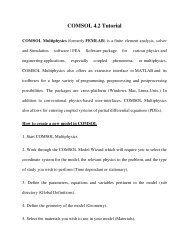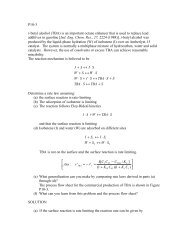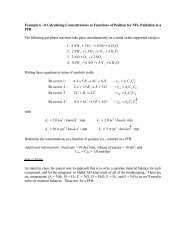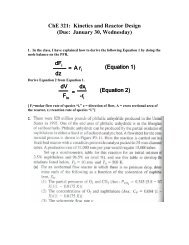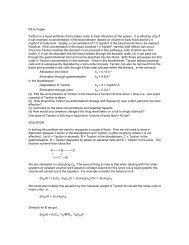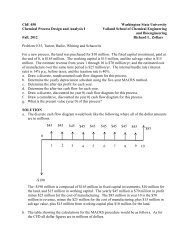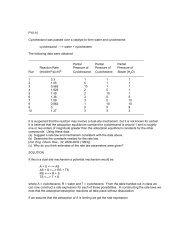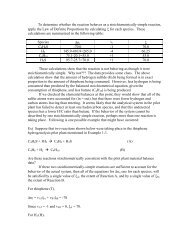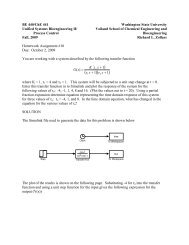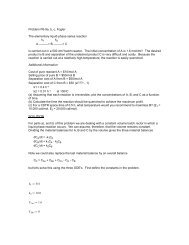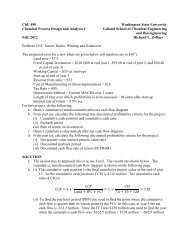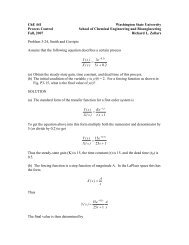Course Objectives and Ground Rules - Gene and Linda Voiland ...
Course Objectives and Ground Rules - Gene and Linda Voiland ...
Course Objectives and Ground Rules - Gene and Linda Voiland ...
You also want an ePaper? Increase the reach of your titles
YUMPU automatically turns print PDFs into web optimized ePapers that Google loves.
ChE 585<br />
Colloid <strong>and</strong> Interfacial Phenomena<br />
Spring, 2010<br />
Washington State University<br />
Voil<strong>and</strong> School of Chemical Engineering<br />
<strong>and</strong> Bioengineering<br />
Richard L. Zollars<br />
Instructor: Richard L. Zollars, Dana 114<br />
Text: An Introduction to Interfaces <strong>and</strong> Colloids: The Bridge to Nanoscience, John C.<br />
Berg, World Scientific, ISBN: 978-981-4293-07-5 (2009).<br />
<strong>Course</strong> <strong>Objectives</strong>: At the completion of this class you should be able to:<br />
1) Describe the effect of surface forces (surface tension) on such phenomena as<br />
capillary rise <strong>and</strong> vapor pressure<br />
2) Determine what structures result in molecules that are attracted to the interfacial<br />
regions. Be able to calculate their concentration <strong>and</strong> their effect of surface<br />
tension.<br />
3) Describe the association phenomena of surface-active materials such as<br />
micellization <strong>and</strong> adsorption.<br />
4) Describe the major forces between colloidal particles, both attractive <strong>and</strong><br />
repulsive. Be able to calculate the effect of these forces on<br />
flocculation/coagulation processes.<br />
5) Be able to use laboratory apparatus to measure colloidal properties including<br />
surface tension, surface pressure vs. surface area relationships, particle size<br />
distribution, zeta potential <strong>and</strong> viscosity.<br />
<strong>Course</strong> Syllabus:<br />
Introduction: basic terminology, description of size (molecular weight)<br />
distribution (1 week)<br />
Surface tension: capillary rise, equations of Kelvin, Young <strong>and</strong> LaPlace, contact<br />
angle effects (2 weeks)<br />
Surface active materials: thermodynamics of micellization, micellar structures<br />
(1 week)<br />
Adsorption from solution: spread monolayers, surface pressure, Langmuir trough<br />
(2 weeks)
Electrokinetics: development of electrostatic surface charges, double layer<br />
theories, effect on flocculation rates (2 weeks)<br />
Electrokinetic phenomena: streaming potential, electrophoresis (3 weeks)<br />
van der Waal forces (1 week)<br />
Colloid stability: DLVO theory, coagulation phenomena (2 weeks)<br />
Measurement techniques: light scattering methods, sedimentation<br />
(centrifugation), electrophoresis, surface tension measurements, viscosity (a<br />
various times throughout the semester)<br />
Policies <strong>and</strong> Procedures:<br />
1) There will be two hour exams <strong>and</strong> a final exam in this class. All exams will be<br />
open book, open notes exams. Each exam will be given equal weight in<br />
determining the course grade. The tests will be graded on a mastery basis – no<br />
curving. Thus it will be possible for every one in the class to get an “A” or a “C”.<br />
2) No make-up exams will be given except for legitimate medical excuses. All<br />
make-ups will be covered by a single exam given near the end of the semester. If<br />
you know ahead of time that you are going to be away for one of the exams (again<br />
only for legitimate reasons such as interview trips) an exam period prior to the<br />
normal exam period will be arranged.<br />
3) All lab work in this class will be done in groups. Every person in the group will<br />
be responsible for participation <strong>and</strong> underst<strong>and</strong>ing of the work being done.<br />
Graduate students will assist in the operation of the equipment required during the<br />
lab periods.<br />
4) There will be a number of problems suggested as homework, but only a few of<br />
these will be h<strong>and</strong>ed-in for credit. You may submit the others to check your work<br />
at any time. Those problems that must be turned-in must be submitted at the<br />
beginning of the class period they are due. No late assignments will be accepted.<br />
Each lab assignment must have the names of all group members who participated<br />
in the solution. By putting your name on any assignment you are verifying that<br />
you have indeed been an active participant.<br />
5) In some of the laboratory exercises data will be shared between groups. Thus<br />
meeting deadlines on collecting data will be imperative. The lab reports will be<br />
short with an emphasis on analysis of the data.<br />
6) The grade for the course will be determined on the following basis: homework –<br />
10%, laboratory reports – 30%, exams – 60%.




